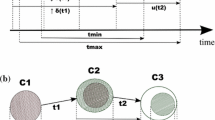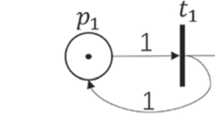Abstract
This paper is about control sequences design for Discrete Event Systems (DES) modeled with Time Petri nets (TPN) including a set of temporal specifications. Petri nets are known as efficient mathematical and graphical models that are widely used to describe distributed DES including choices, synchronizations and parallelisms. The domains of application include but are not restricted to manufacturing systems, computer science and transportation networks. Incorporating the time in the model is important to consider many control problems such as scheduling and planning. This paper solves some control issues in timed context and uncertain environments that include unexpected events modeled with uncontrollable transitions. To deal with such uncertainties, we propose first to build an Approximated Timed Reachability Graph that includes the time specifications and model all feasible timed trajectories at a given accuracy under earliest firing policy. Then, this graph is used to search optimal paths by using an approach based on Markov Decision Processes that encode the environment uncertainties. Such optimal paths lead to near-optimal solutions for the TPN. Several simulations illustrate the benefit of the proposed method from the performance and computational points of view.













Similar content being viewed by others
References
Alur R, Henzinger T (1999) Reactive modules. Formal Methods in System Design 15(1):7–48
Baker KR, Trietsch D (2009) Principles of Sequencing and Scheduling. Wiley
Basile F, Cabasino MP, Seatzu C (2015) State estimation and fault diagnosis of labeled time petri net systems with unobservable transitions. IEEE Trans Autom Control 60(4):997–1009
Beccuti M, Franceschinis G, Haddad S (2007a) Markov decision petri net and Markov decision well-formed net formalisms. LNCS 4546:43–62
Beccuti M., Codetta-Raiteri D, Franceschinis G, Haddad S (2007b) A framework to design and solve Markov Decision Well-formed Net models. In Proc. of the 4th IEEE Int. Conf. on Quantitative Evaluation of Systems (QEST’07); 165–166, Edinburgh, Scotland, UK
Beccuti M, Franceschinis G, Haddad S (2011) A framework to design and solve Markov decision petri nets. IJPE 7(5):417–442
Bellman RE (1957) Dynamic programming. Princeton University Press, Princeton
Berthomieu B, Diaz M (1991) Modeling and verification of time dependent systems using time petri nets. IEEE T Software Eng 17(3):259–273
Berthomieu B, Menasche M (1983) An enumerative approach for analyzing time petri nets. In IFIP Congress, pages 41–46
Berthomieu B, Vernadat F (2003) State class constructions for branching analysis of time petri nets. In TACAS 2003, volume 2619 of LNCS, pages 442–457. Springer
Cassandras C (1993) Discrete event systems: modeling and performances analysis. Aksen Ass. Inc. Pub.
Chen Y, Li Z, Khalgui M, Mosbahi O (2011) Design of a Maximally Permissive Liveness-Enforcing Petri net Supervisor for flexible manufacturing systems. IEEE Trans Autom Sci Eng 8(2):374–393
Cormen TH, Leiserson CE, Rivest RL, Stein C (2001) Introduction to algorithms. MIT Press and McGraw-Hill
Daoui C, Abbad M, Tkiouat M (2010) Exact decomposition approaches for Markov decision processes: a survey. Advances in Operations Research 2010:1–19
David R, Alla H (1992) Petri nets and grafcet – tools for modelling discrete events systems. Prentice Hall, London
Dijkstra EW (1971) A short introduction to the art of programming
Eboli MG, Cozman FG (2010) Markov decision processes from colored petri nets, SBIA 2010. Lecture Notes in Computer Science, vol 6404. Springer
Gardey G, Roux OH, Roux OF (2003) Using zone graph method for computing the state space of a time petri net. In FORMATS 2003, volume 2791 of LNCS, pages 246–259. Springer
Haddad S, Moreaux P (2009) Stochastic Petri Nets (Chapter 7), In Petri Nets: Fundamental Models and Applications. Wiley
Heidari P, Boucheneb H (2012) Maximally permissive controller synthesis for time petri nets. Int J Control
Heidari P, Boucheneb H (2013) Controller synthesis of time petri nets using stopwatch, Journal of Engineering, Hindawi Publishing Corporation, Article ID 970487
Jeng MD, Chen SC (1998) Heuristic search approach using approximate solutions to petri net state equations for scheduling flexible manufacturing systems. Int J FMS 10(2):139–162
Klai K, Aber N, Petrucci L (2013) A new approach to abstract reachability state space of time petri nets. 20th International Symposium on Temporal Representation and Reasoning
Lee DY, DiCesare F (1994) Scheduling flexible manufacturing systems using petri nets and heuristic search. IEEE Trans Robot Autom 10(2):123–133
Lefebvre D (2016a) Approaching minimal time control sequences for timed petri nets. IEEE Trans Autom Sci Eng 13(2):1215–1221
Lefebvre D (2016b) Deadlock-free scheduling for Timed Petri Net models combined with MPC and backtracking. Proc. IEEE WODES 2016, Invited session “Control, Observation, Estimation and Diagnosis with Timed PN”, pp. 466-471, **’an, China
Lefebvre D, Leclercq E (2015) Control design for trajectory tracking with untimed petri nets. IEEE Trans Autom Control 60(7):1921–1926
Lei H, **ng K, Han L, **ong F, Ge Z (2014) Deadlock-free scheduling for flexible manufacturing systems using petri nets and heuristic search. Comput Ind Eng 72:297–305
Leung Y-T (2004) Handbook of Scheduling: Algorithms, Models, and Performance Analysis. Chapman & Hall/CRC Computer & Information Science Series
Lime D, Roux OH (2006) Model checking of time petri nets using the state class timed automaton. DEDS 16(2):179–205
Lopez P, Roubellat F (2008) Production scheduling. ISTE/Wiley, London
Mejia G, Nino K (2017) A new hybrid filtered beam search algorithm for deadlock-free scheduling of flexible manufacturing systems using petri nets. Comput Ind Eng 108:165–176
Merlin P, Faber DJ (1976) Recoverability of communication protocols. IEEE Trans Commun 24(9):1036–1043
Pan L, Ding Z, Zhou MC (2014) A configurable state class method for temporal analysis of time petri nets. IEEE Trans Syst Man Cybern Syst 44(4):482–493
Puterman M (1994) Markov decision processes: discrete stochastic dynamic programming. Wiley, New York
Ramchandani C (1973) Analysis of asynchronous concurrent systems by timed petri nets. Ph. D, MIT, USA
Reyes-Moro A, Hu H, Kelleher G (2002) Hybrid heuristic search for the scheduling of flexible manufacturing systems using petri nets. IEEE Trans Robot Autom 18(2):240–245
Tarek A, Lopez-Benitez N (2004) Optimal legal firing sequence of petri nets using linear programming. Optim Eng 5:25–43
Tuncel G, Bayhan GM (2007) Applications of petri nets in production scheduling: a review. Int J Adv Manuf Technol 34:762–773
Acknowledgements
The Project MRT MADNESS 2016-2019 has been funded with the support from the European Union with the European Regional Development Fund (ERDF) and from the Regional Council of Normandie.
Author information
Authors and Affiliations
Corresponding author
Additional information
Publisher’s note
Springer Nature remains neutral with regard to jurisdictional claims in published maps and institutional affiliations.
Rights and permissions
About this article
Cite this article
Lefebvre, D. Approximated timed reachability graphs for the robust control of discrete event systems. Discrete Event Dyn Syst 29, 31–56 (2019). https://doi.org/10.1007/s10626-019-00275-z
Received:
Accepted:
Published:
Issue Date:
DOI: https://doi.org/10.1007/s10626-019-00275-z




